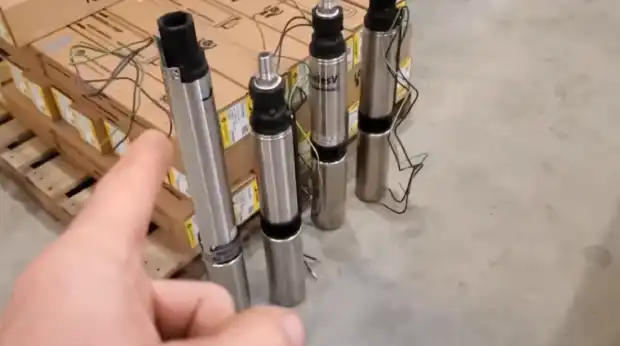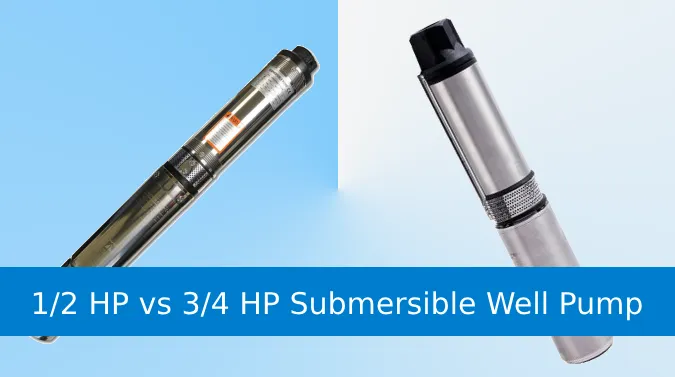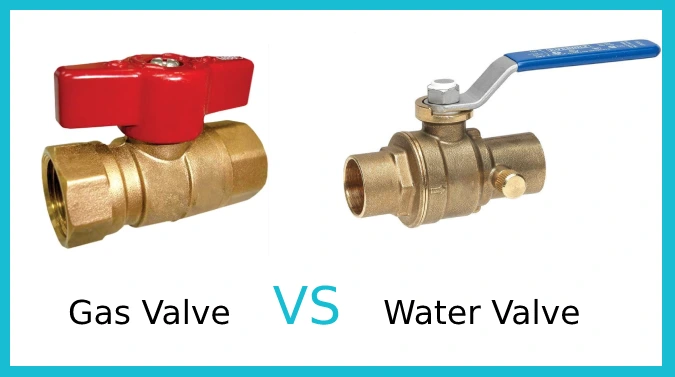Last Updated on July 10, 2023
Can’t decide between a 1/2 HP or 3/4 HP submersible well pump? It’s important to know that the difference in horsepower can actually have a significant impact on performance. While both types serve the same purpose of delivering water to your home, there are notable differences worth considering.
The flow rate of a 1/2 HP submersible well pump is usually around 10 gallons per minute (GPM). However, a 3/4 HP submersible well pump can deliver up to 13 GPM. In some cases, a 1/2 HP submersible well pump is enough, but for deeper wells or more water, a 3/4 HP pump is better.
Also in the long run, you can get better water pressure and improved performance with a 3/4 HP pump. Today, we’ll compare 1/2 HP and 3/4 HP submersible well pumps so you can decide which is best for you. Keep reading for more info.
1/2 HP vs 3/4 HP Submersible Well Pump: Key Differences Explored

If you’re in the market for a submersible well pump, you must understand the key differences between a standard horsepower (HP) model and a 3/4 HP model. The following are some significant differences between these two pumps:
- Power Output
- Flow Rate (GPM)
- Maximum Pressure (PSI)
- Depth Capability
- Maximum Head
- Vertical Lift Capacity
- Horizontal Pipe Length
- Energy Consumption
- Cost
- Suitable Applications
Power Output:
You’ll be amazed at the increased power output with a 3/4 HP submersible well pump compared to a 1/2 HP one. The horsepower rating is a key indicator of the motor’s power output.
A 3/4 HP pump can deliver more water at a higher pressure than a 1/2 HP pump. To better understand the power output difference between a 1/2 HP and a 3/4 HP submersible well pump, here are some key points to consider:
- A 3/4 HP pump can pump water from greater depths than a 1/2 HP pump.
- A 3/4 HP pump can deliver water faster than a 1/2 HP pump, making it more suitable for larger households or commercial use.
- A 3/4 HP pump can handle more demanding applications, such as irrigation or livestock watering.
- A 3/4 HP pump can provide better water pressure to a home or building, especially if the water source is far from the point of use.
Flow Rate (GPM):
Get ready to experience a higher flow rate with the 3/4 pump. As mentioned earlier, a 3/4 HP submersible well pump can deliver a flow rate of up to 13 GPM, higher than the typical 10 GPM flow rate provided by a 1/2 HP pump.
This means that you can expect to draw more water from your well in less time with the 3/4 HP pump. The flow rate of a well pump is an important factor to consider when selecting a pump for your well.
A higher flow rate will ensure enough water to meet your needs if you have a high demand for water or a large household. Also, a higher flow rate can reduce the time it takes to fill a large tank or supply water to an irrigation system.
Maximum Pressure (PSI):
Achieve higher water pressure with the 3/4 pump, which can generate up to 85 psi, allowing you to spray water up to 85 feet away powerfully. This increased pressure can be useful for larger properties or households with multiple water users, providing a stronger and more consistent water flow.
Here are some key benefits of using a 3/4 HP submersible well pump for maximum pressure:
- Higher pressure allows greater control over water flow and distribution, making irrigating large fields or gardens easier.
- A 3/4 HP pump’s increased power can also help overcome common well water issues, such as low water pressure, sediment buildup, and water quality problems.
- With a 3/4 HP pump, you can also enjoy a faster and more efficient water supply, as the increased pressure can help to fill tanks and reservoirs more quickly.
- Finally, a 3/4 HP pump can provide greater peace of mind, as it’s less likely to fail or malfunction under heavy use, reducing the risk of costly repairs or downtime.
Depth Capability:
When choosing a submersible well pump, consider the depth of your well to choose the appropriate pump. If your well has a greater water depth, the appropriate option would be the 3/4 pump.
This is because the 3/4 HP pump can reach much greater depths than the 1/2 HP pump. The 3/4 HP pump can typically handle depths of up to 300 feet. While the 1/2 HP pump is better suited for shallow wells or those with a high water table, with a depth capability of around 200 feet.
Installing a pump with a lower depth capability than your well requires can result in insufficient water supply and damage to the pump.
Vertical Lift Capacity:
Now that you understand the maximum head difference between a 1/2 HP and 3/4 HP submersible well pump, let’s talk about their vertical lift capacity.
As mentioned earlier, a 1/2 HP pump can lift water up to 10 feet vertically. However, with a 3/4 HP pump, you can expect to lift water up to 25 feet vertically. This increased lift capacity is due to the higher power output of the 3/4 HP motor.
It’s important to note that the vertical lift capacity can vary depending on other factors such as the size of the well casing and the amount of water in the well. The lift capacity may also decrease if the pump is used for continuous or heavy-duty applications.
Horizontal Pipe Length:

To determine the appropriate horizontal pipe length for your application, you should consider the power output of your pump and the distance between the well and the intended water source.
If you have a 1/2 HP pump, limit the horizontal pipe length to 3 to 25 feet. Going beyond this range can cause a pressure drop, resulting in reduced or no water flow.
On the other hand, if you have a 3/4 HP pump, you can accommodate longer horizontal pipe lengths, extending from 150 to 250 feet. However, you should still be mindful of the distance between the well and the intended water source, which can also affect the pump’s performance.
Here are some important points to keep in mind regarding the horizontal pipe length of your well pump:
- The longer the horizontal pipe length, the greater the friction loss, which can negatively impact the pump’s performance.
- The pipe diameter also affects the pump’s performance. A larger diameter pipe can help reduce friction loss, allowing for longer horizontal pipe lengths.
- If you need to extend the horizontal pipe length beyond the recommended range for your pump, consider using a booster pump or a larger pump to maintain adequate water flow and pressure.
Energy Consumption:
You might be surprised that a higher-powered pump could be a real energy hog, draining your wallet like a thirsty elephant at a watering hole. Generally, a 3/4 HP pump requires more electrical power than a 1/2 HP pump.
This means that if you have a 3/4 HP submersible well pump, it could consume more electricity than a 1/2 HP pump. However, note that energy consumption can vary depending on the specific design and efficiency of the pump, so it’s essential to consider energy efficiency ratings and other factors when choosing a pump.
To determine the energy consumption of a submersible well pump, you must consider its power consumption, measured in watts. The power consumption is a function of the motor’s power rating, load, and efficiency.
Higher-efficiency pumps consume less electricity, meaning the cost of running them is lower than that of less efficient pumps. Therefore, when choosing a submersible well pump, consider its energy efficiency rating and compare it with other pumps to find the most energy-efficient option.
Cost:
If you’re looking for an affordable option, the 1/2 horsepower pump may be the way to go. As mentioned earlier, the cost of a 1/2 HP submersible well pump starts from $175 and can go up to around $800, depending on the brand and features.
However, it’s important to note that the cost can vary greatly depending on the brand and features. If you’re on a tight budget and don’t need a high flow rate, a 1/2 HP pump may be a more cost-effective option for you.
Suitable Applications:
If you have an average-sized house with a shallow water level or moderate water demand, a 1/2 HP pump is typically sufficient for your needs. Conversely, if you have a larger house with multiple families relying on one pump or expect a higher water demand, a 3/4 HP pump may be a better choice.
It’s important to consider the specific needs of your household when selecting a submersible well pump. Factors such as the depth of your well, the number of people in your home, and your daily water usage should all be considered.
Is it better to have a higher HP well pump?

Opting for a higher horsepower submersible well pump can increase water flow and greater pressure, making it a more efficient choice for households with higher water demands.
Here are three reasons why a higher horsepower well pump could be a better option for you:
- Deeper Wells: A higher horsepower pump would be more suitable for your needs if you have a deeper well. A deeper well requires more power to lift the water to the surface, and a higher horsepower pump can handle this task with ease.
- Greater Water Demand: If your household requires more water, a higher horsepower pump can ensure that the water flow remains consistent and that there is always enough water available.
- Longer Pump Life: A higher horsepower pump can operate at a lower RPM, which reduces wear and tear on the pump’s motor. This can extend the pump’s life, which is beneficial in the long run as it reduces the need for frequent replacements and maintenance.
How deep can a 3/4 hp submersible well pump go?
The 3/4 HP 2873G-13 submersible well pump can deliver efficient water from depths of up to 200 feet, making it a reliable option for most residential wells.
This pump is designed to pump water from deep wells efficiently, and it comes equipped with a powerful motor that can deliver up to 12 gallons of water per minute from depths of 100 feet.
Its efficient design ensures that the pump operates quietly and with minimal energy consumption, making it an ideal choice for homeowners looking to save on their energy bills.
How deep can a 1/2 hp submersible well pump go?
If you’re wondering how deep a 1/2 horsepower submersible pump can go, you’ll be pleased to know that it can effectively pump water from wells at least 4 inches in diameter and up to 150 feet deep.
The Simer 1/2 HP submersible pump is specifically designed for use in wells with these specifications, ensuring that it operates efficiently and provides a reliable water supply for your needs.
However, it’s worth noting that the depth and efficiency of a 1/2 HP submersible pump may vary depending on factors such as the condition and size of the well, the amount of water available, and the type of pump system used.
How long does a 3/4 hp & 1/2 hp submersible well pump last?
Now that you know how deep a 1/2 hp submersible well pump can go, let’s talk about how long it can last. The lifespan of any well pump can vary depending on factors such as usage and type of pump, but on average, a 1/2 hp submersible well pump can last between 8 and 15 years.
However, it’s important to note that regular maintenance and proper usage can extend the lifespan of your pump.
How much power does a 1/2 hp & 3/4 hp submersible well pump need?
The 1/2 HP submersible well pump has a running wattage of 900 and a starting wattage of 2000. In contrast, the 3/4 HP submersible well pump has a higher running wattage of 1500 and a starting wattage of 3000.
This means the 3/4 HP submersible well pump requires more power to start and operate than the 1/2 HP one. Remember that the power requirements of a submersible well pump depend on several factors, such as the depth of the well, the pressure and flow rate of the water, and the pump size.
Generally, a larger and more powerful pump is needed for deeper wells or to pump water up to higher elevations. However, choose the right size of pump that meets your specific needs and is energy efficient to minimize operational costs.
1/2 HP or 3/4 HP Submersible Well Pump: Choose the Right Submersible Well Pump
Whether you choose a 1/2 HP or 3/4 HP submersible well pump, remember that both can provide you with a reliable water source. Consider the depth of your well, the power requirements, and the pump’s longevity before making your final decision.
Now that you have a deeper understanding of the capabilities and limitations of each, you can make an informed decision on which one is best suited for your needs.
But before you make your final decision, let’s take a moment to reflect on the importance of a well pump. It’s easy to take for granted the convenience of having a constant supply of clean water at our fingertips.
However, for many people worldwide, access to clean water is a luxury they can only dream of. So, as you make your decision, remember the privilege you have and the impact it can have on your daily life.



